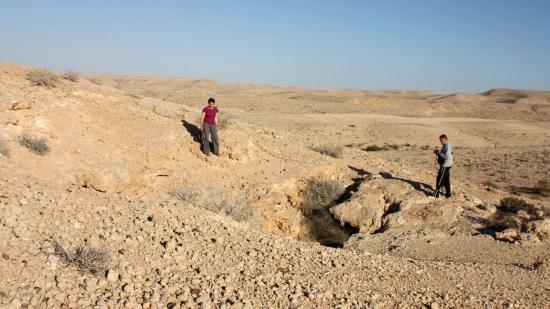Analysis of 6,000-year old large lead bead found indicates that the ore came from Anatolia.
Ruth Schuster
Source - http://www.haaretz.com/jewish/archaeology/.premium-1.690151
 The Ashalim Cave lead object, found by a team of Israeli archaeologists.Naama Yahalom-Mack et al
The Ashalim Cave lead object, found by a team of Israeli archaeologists.Naama Yahalom-Mack et al
A large lead bead-like object with a stick through it, dating back 6,000 years, was discovered deep in a cave by archaeologists in Israel – but analysis of the metal indicates that it came from southern Turkey, revealing that either the lead ore or the object had been imported.
There is ample evidence of brisk trade between the Levant and Anatolia; copper artifacts of that period, the Late Chalcolithic, may also have originated from Anatolian ore. Other trade included the import of obsidian to the Levant, which had already begun in the Neolithic period, say the archaeologists.
The object found deep in Ashalim Cave in the northern Negev is the only pre-4th millennium lead artifact ever uncovered in the Levant, writes the archaeological team headed by Naama Yahalom-Mack in their paper, "The Earliest Lead Object in the Levant," published in Plos One. The paper was written by archaeologists from the Hebrew University of Jerusalem and Tel Aviv University.
 Archeaologists stand at the entrance to the Ashalim Cave in the Negev desert.Naama Yahalom-Mack et al
Archeaologists stand at the entrance to the Ashalim Cave in the Negev desert.Naama Yahalom-Mack et al
The artifact, which looks like a conic bead, is 3.5 centimeters long, with a 22.4-centimeter long wooden shaft through its middle. Its purpose is a riddle, though the archaeologists speculate that it may have been used as a spindle whorl. "Abrasion marks are visible at the bottom of the lead object, possibly as a result of use," they point out.
On the other hand, they note that it's a tad heavy for a whorl and would have produced coarse yarn. "We may speculate that the lead object was originally used in another context, which would have made it possible to acknowledge its rarity and significance (e.g., as a macehead), before being re-used as a spindle whorl, joined to the wooden rod, at a later stage," they write.
Radiocarbon dating of the wood through its middle places the object within 4300 to 4000 BCE, the Late Chalcolithic period. The wood itself is local — tamarisk wood, which is native to the Negev.
Copper smelting and use was typical of the Late Chalcolithic but lead artifacts only began to appear about thousand years later, apparently as a byproduct of silver production. In the 4th millennium BCE silver "quite suddenly" appeared over a wide area, including Mesopotamia, Iran, Anatolia and the Levant, says the team. Silver, extracted from lead ore, was evidently the smelters' primary objective: The lead produced in the process was used mainly by fishermen to hold down nets or as filler in bronze commercial weights, they say. It was also mixed into copper alloys.
The lead object found at Ashalim is apparently the oldest smelted lead object found yet, says the team. Previous findings, all from northern Mesopotamia and eastern Anatolia, include a bracelet dated to about 5,700 BCE and a small conical object dated to the 5th millennium BCE. (There is an older artifact from the 7th millennium BCE but its origin from smelting is debated.)
The bi-conical bead consisted of almost pure metallic lead. Chemical and isotope analyses indicate that the ore originated in the Taurus mountain range in Anatolia, though whether it arrived in Israel as ore for processing or as a finished product is not known.
The fact that the artifact was placed in the deepest section of Ashalim Cave, in a burial chamber, attests that it may have held symbolic significance, Yahalom-Mack and the research team suggest.
Ashalim is a complex cave system that has been undergoing exploration and excavation since the 1970s. A survey done in 2012 concluded that during the Late Chalcolithic period, certain inner sections of the cave were reserved for burials. Findings included pottery and the bones of two people. Mortuary activity seems to have been the sole reason for human presence in this "deep, remote maze-like cave," write the archaeologists, hence the theory that the spindle whorl, if that is what it was, would probably be related to that activity.